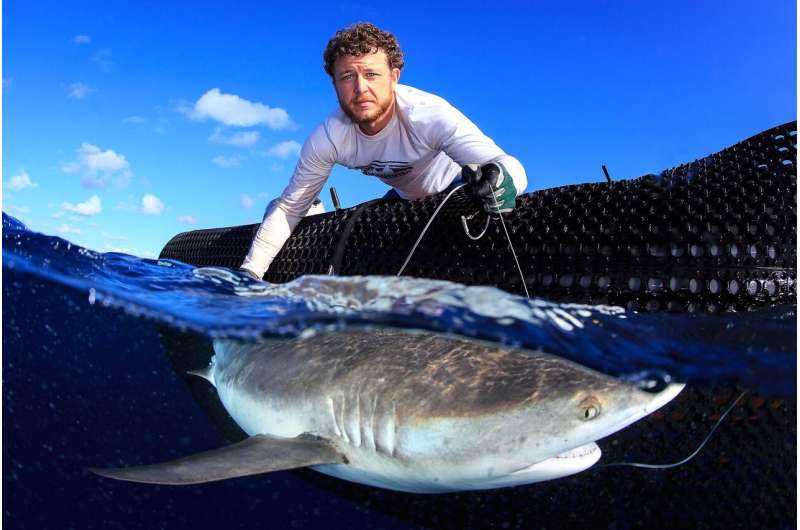Blue sharks ride deep-swirling currents to the ocean's midwater at mealtime

When you're hungry, wouldn't it be nice to just slip into a tunnel that rushes you off to a grand buffet? It sounds like something Elon Musk might dream up, but it turns out, certain species of sharks appear to have this luxury.
Last year, researchers at Woods Hole Oceanographic Institution (WHOI) and the Applied Physics Lab at the University of Washington (UW) discovered that when white sharks are ready to feast, they ride large, swirling ocean currents known as eddies to fast-track their way to the ocean twilight zone—a layer of the ocean between 200 and 1000 meters deep (656 to 3280 feet) containing the largest fish biomass on Earth. Now, according to a new study in Proceedings of the National Academy of Sciences (PNAS), scientists are seeing a similar activity with blue sharks, which dive through these natural, spinning tunnels at mealtime. The eddies draw warm water deep into the twilight zone where temperatures are normally considerably colder, allowing blue sharks to forage across areas of the open ocean that are often characterized by low prey abundance in surface waters.
To track their movements, the researchers tagged more than a dozen blue sharks off the Northeast Coast of the U.S. and monitored them for a period of nine months. According to Simon Thorrold, a senior scientist at WHOI and co-author of the study, each shark was "double tagged" on their dorsal fins; one tag monitored ocean temperatures and depth as the sharks moved through the ocean and the other tag tracked their location. This double-tagging strategy allowed the scientists to reproduce the three-dimensional tracks of the sharks with the resolution and accuracy needed to link their movements to the positions of ocean currents like eddies.
Data relayed from the tags via satellite to labs at WHOI and UW revealed that the sharks spent a good portion of their days diving these warm-water tunnels to the ocean twilight zone hundreds of meters below the surface. There, they'd spend an hour or so foraging before swimming back to the surface to warm up before diving again.
Dives were less frequent at night, when many twilight zone animals make their daily migration from the ocean's mid-water to the surface. According to Camrin Braun, an ocean ecologist at UW and lead author of the study, a trip to the twilight zone at night isn't really worth it for hungry blue sharks since their "deep ocean buffet" isn't particularly well stocked after dark.
"Sharks are all about opportunity, so with fewer prey items down there at night, they're just not going to make the trip," he said. "Going down there is costly for them from an energetic and metabolic standpoint."
Braun, who conducted the research as a Ph.D. student in the MIT-WHOI Joint Program in Oceanography before working at UW, says that the behavior of the blue sharks was generally similar to that of the white sharks tracked in the previous study. However, the two species had different preferences when it came to water temperature. White sharks, which are warm-blooded animals, used a combination of warm- and cold-water eddies as a conduit to the twilight zone, while blue sharks—a cold-blooded species—relied exclusively on warm-water eddies.
"Blue sharks can't regulate their body temperature internally to stay warmer than the ambient seawater like white sharks can, so they need to control it behaviorally," said Braun. "We think this is why they show a clear preference for the warm-water eddies—it removes a thermal constraint to deep diving."

In general, when it comes to the secret lives of large apex predators like sharks, scientists know relatively little. This research, according to Thorrold, helps fill important knowledge gaps about where they go and why, which can inform decision making on where to implement marine protected areas to conserve them. And, the work underscores the importance of the ocean twilight zone as a critical biomass resource.
"The twilight zone is vulnerable to overfishing," he said. "If we're harvesting low-value fish there at the expense of high-value fish like blue sharks and other pelagic predators, that's probably not a good tradeoff."
More information: Camrin D. Braun et al. Mesoscale eddies release pelagic sharks from thermal constraints to foraging in the ocean twilight zone, Proceedings of the National Academy of Sciences (2019). DOI: 10.1073/pnas.1903067116
Journal information: Proceedings of the National Academy of Sciences
Provided by Woods Hole Oceanographic Institution



















